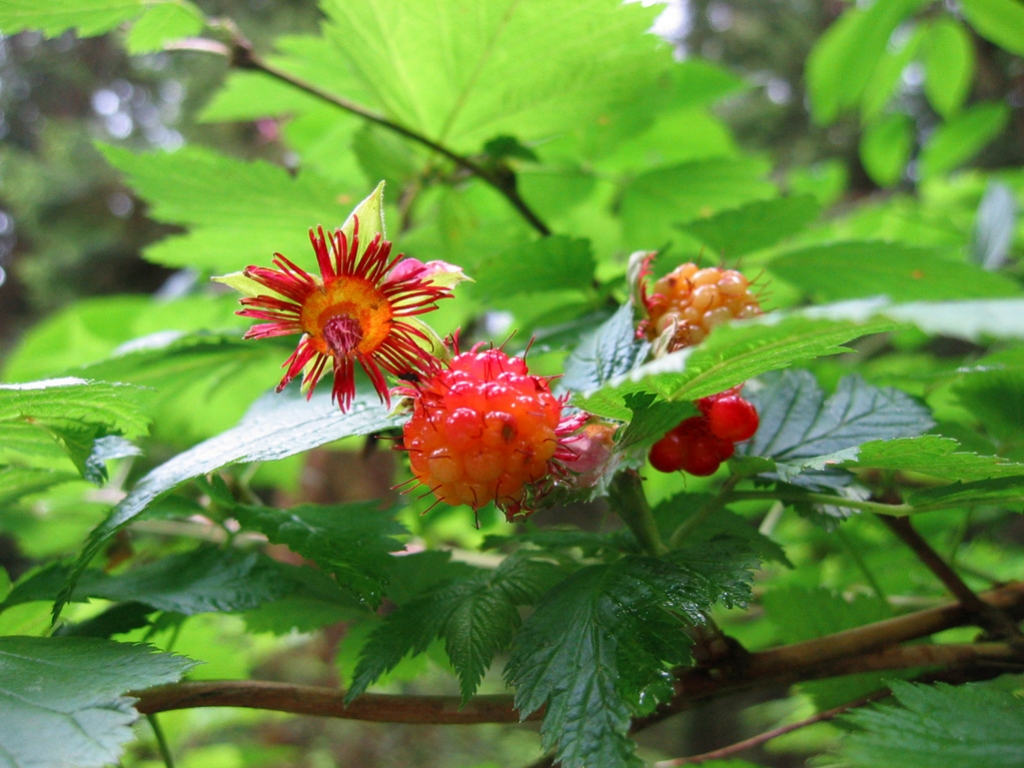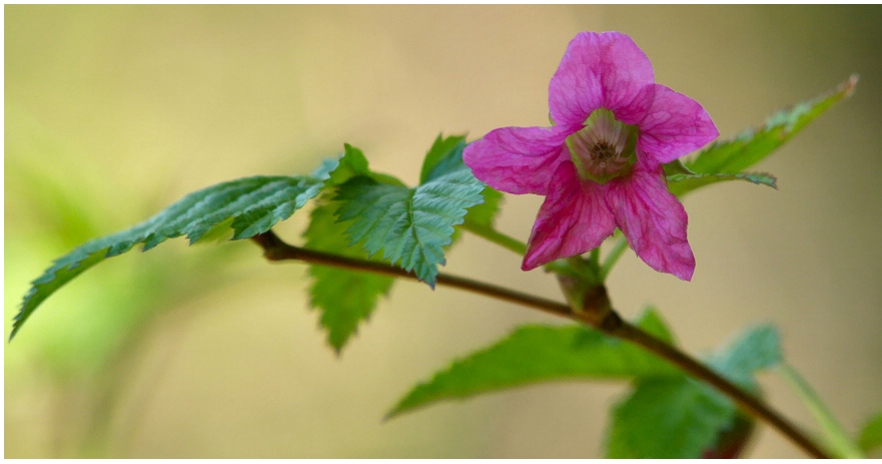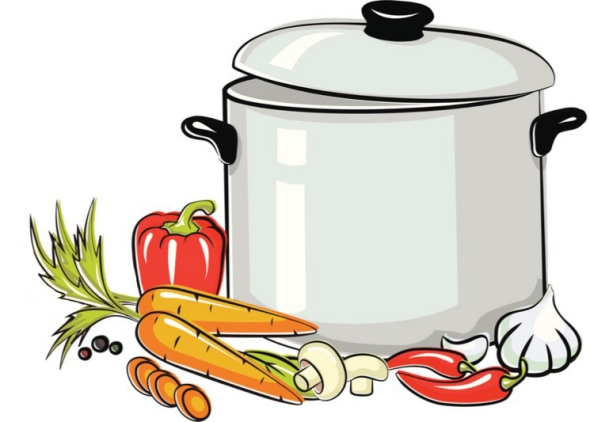Salmonberries
FNH-00119 View this publication in PDF form to print or download.
A member of the rose family, the salmonberry plant (Rubus spectabilis) is related to the raspberry, nagoonberry, wild strawberry, thimbleberry and cloudberry. Do not confuse salmonberries with cloudberries, sometimes referred to as lowbush salmonberries.
Salmonberries can be found in moist, coastal regions of Southeast, Southcentral and Southwest Alaska. The berries grow on woody shrubs up to seven feet high; the tall, thorny stalks grow on stream banks and alpine slopes, in moist coastal meadows and in avalanche chutes. The leaves are made up of three-toothed leaflets up to five inches long. The rosy-purple flowers have five petals and are solitary on the stalk. Each flower produces a salmon-yellow or red fruit similar in appearance to large raspberries; yellow, orange and red berries may all be seen on a single plant.
Nutrition
Salmonberries are a good source of pro-vitamin A and a good source of vitamin C. Table 1 provides a comparison of the vitamin C and A levels in salmonberries and blueberries.

Table 1. Vitamin A and C levels for blueberries and salmonberries
| Berry (1 cup raw) | Vitamin C (mg) | Vitamin A (IU) |
|---|---|---|
| Blueberries | 26.5 | 167 |
| Salmonberries | 13 | 719 |
Salmonberries, like all Alaska wild berries, have high levels of antioxidants. Antioxidants are a group of physiologically active compounds that work to

neutralize free radicals (molecules with unpaired electrons). Research has found that free radicals contribute to the aging process by damaging healthy cells. To this extent, antioxidants have shown to be an important part of the human diet.
Researchers test the levels of antioxidants in foods using the Oxygen Radical Absorption Capacity test (ORAC). This test measures the amount of antioxidant in a given food. A score of 20 indicates high levels of antioxidants, levels of 30 are considered very high and anything over 40 is extremely high. Salmonberries have an ORAC score of 40.
Processing affects the antioxidant levels of the berries. While juicing appears to lower antioxidant levels, other methods produce very high and extremely high levels of antioxidants. Table 2 lists the ORAC values of wild Alaska salmonberry products.
Table 2. ORAC values for salmonberry products
| Salmonberries | ORAC |
|---|---|
| Dried berries | 540 |
| Fruit leather | 98 |
| Frozen fruit | 40 |
| Frozen juice | 15 |
| Canned juice | 15 |
| Canned fruit | 55 |
| Jam |
30 |
| Syrup | 10 |
Salmonberries should be harvested in mid-to late summer depending on the location. Hand picking is the best method for collecting salmonberries since the fruit is extremely fragile.
Mature salmonberries are very juicy and can be eaten raw or made into jams, jellies and syrups. Salmonberry seeds are tough after cooking, so many recipes suggest removing seeds prior to use by pressing softened berries through a food mill.
Storage and Preservation
How to Clean and Store
Because they are fragile, salmonberries should be handled as little as possible. Unless they are exceptionally dusty, do not wash. Pick through the berries to remove any leaves or debris. For best flavor, eat the raw berries the same day they are picked.
Salmonberries may be stored in the refrigerator for a brief period of time. They will not keep well for more than two to three days. Store cleaned berries in a shallow container to prevent crushing. Place the covered container in the refrigerator.
- To sterilize canning jars, boil in water for 5 minutes.
- To prepare two-piece lids (rings and tops), wash, rinse set aside until ready to use. Follow manufacture’s directions for use.
- If less sugar is desired in recipes calling for pectin, be sure to use no-sugar-needed pectin and follow the instructions on the box.
- See later instructions on this page for how to use a boiling water canner.
How to Freeze
Spread salmonberries in a single layer on a cookie sheet and place in the freezer. Transfer frozen berries to freezer bags or containers. Properly frozen salmonberries will last up to two years.
How to Dry
Drying is not recommended for salmonberries as they are too seedy and slow to dry. Salmonberry puree may be used to make fruit leather.
How to Extract Juice
Combine 4 cups clean salmonberries with 1 cup water. Bring to a simmer, cover and simmer for 10 minutes. Occasionally crush the simmering berries to release the juice. To separate the juice from the berries, pour the hot mixture into a jelly bag or use layers of cheesecloth placed in a colander. Let the juice drip into a bowl. For clear juice, do not twist or press the berries while they drain. For long-term storage, the juice should be frozen or canned.
Yield: 2 cups
Hot pack for juice
Sterilize canning jars. Heat juice, stirring occasionally, until it begins to boil. Pour into hot jars, leaving ¼ inch headspace. Wipe jar rims. Adjust lids. Process in a boiling water canner.
- Half pints, pints or quarts: 5 minutes
- Half gallons: 10 minutes
How to Prepare Puree
Cooked method: Add 1 cup water to 4 cups clean salmonberries. Cook until berries are soft. Press berries through a food mill or sieve. Juice can be retained with the berries. Discard skins and seeds.
Yield: 2 cups
Canning: Reheat prepared puree to boiling. If desired, add sugar to taste. If sugar is added, boil mixture until it dissolves. Pack puree into hot jars, leaving ¼ inch headspace. Remove air bubbles. Wipe jar rims. Adjust two- piece lids. Process half pints, pints or quarts in a boiling water canner for 15 minutes.
Yield: 2 cups
Freezing: Pack prepared puree into rigid containers leaving ½ inch headspace to allow for expansion in freezing. Seal, label and place in the freezer.
Recipes
Salmonberry Freezer Jam
- 2 cups salmonberry juice
- 1 cup crushed salmonberries
- 5¼ cups sugar
- 1 package powdered pectin (1¾ ounces)
- ¾ cup water
In a large bowl, mix 2 cups of salmonberry juice with 1 cup crushed salmonberries. Stir in the sugar and mix well. Set aside for 10 minutes or until the sugar is completely dissolved.
Combine ¾ cup water and the powdered pectin in a small saucepan. Over high heat, bring mixture to a full, rolling boil, stirring constantly. Continue boiling for 1 minute. Stir the pectin/water mixture into the berry mixture. Stir constantly for 3 minutes.
Fill freezer containers leaving a ½ inch headspace. Cover the containers with tight lids and allow to stand at room temperature for 24 hours or until the jam is set. Store in freezer until ready to use. After opening, store in refrigerator for up to three weeks.
Yield: 3 cups
Salmonberry Rhubarb Jam
- 1 cup salmonberries, crushed (you may want to remove some of the seeds)
- 2 cups rhubarb, diced
- 3 cups sugar
Sterilize pint or half-pint canning jars and prepare lids. In a large saucepan, combine all ingredients and bring slowly to boiling, stirring occasionally until sugar dissolves. When sugar is dissolved, increase heat and cook rapidly to gelling point, 220 ̊F. As mixture thickens, stir frequently to prevent sticking.
Pour jam into hot jars, leaving ¼ inch headspace. Wipe jar rims and add two-piece lids. Process 5 minutes in a boiling water canner.
Yield: 3 cups
Salmonberry Jelly
- 4 cups salmonberry juice
- 1 package powdered pectin (1¾ ounces)
- 5½ cups sugar
Sterilize pint or half-pint canning jars and prepare lids. Measure sugar and set aside. Measure salmonberry juice into a large saucepan. Add pectin and stir until dissolved. Over high heat, bring the mixture to a full, rolling boil that cannot be stirred down. At once stir in sugar. Again, bring to a full rolling boil. Boil hard for 1 minute, stirring constantly. Remove from heat and quickly skim off foam. Immediately pour jelly into hot canning jars, leaving ¼ inch headspace. Wipe jar rims and add two-piece lids. Process 5 minutes in a boiling water canner.
Yield: 6 cups
- Fill the canner halfway with water. Preheat water to a low boil. Place filled jars, fitted with lids, into the canner on the rack. Add more boiling water, if needed, so the water level is at least 1 inch above jar tops. Turn heat to its highest position until water boils vigorously. When the water boils, set a timer for the recommended processing time indicated in the recipe. Cover with the canner lid and lower heat setting to maintain a gentle boil throughout the processing time. Add more boiling water, if needed, to keep the water level above the jars.
- When the jars have been boiled for the recommended time, turn off the heat and remove the canner lid. Using a jar lifter, remove the jars and place them on a towel, leaving at least 1 inch of space between the jars during cooling.
- After cooling jars for 12 to 24 hours, remove the screw bands and test seals. Press the middle of the lid with a finger. If the lid springs up when finger is released, the lid is unsealed. If a lid fails to seal on a jar, remove the lid and check the jar-sealing surface for tiny nicks. If necessary, change the jar, add a new, properly prepared lid and reprocess within 24 hours using the same processing time. Alternately, adjust headspace to 1½ inches and freeze or store in the refrigerator and use within three days.
- If lids are tightly sealed on cooled jars, remove screw bands, wash the lid and jar
to remove food residue, then rinse and dry jars. Label and date the jars. Store
in a clean, cool, dark, dry place.

Salmonberry Fruit Leather
- 2 cups salmonberry puree
- 2 tablespoons honey (to taste)
Prepare puree and combine with honey. Line a cookie sheet with microwaveable plastic wrap. Spread puree mixture evenly, about ¹⁄8 to ¼ inch thick, over the plastic, but do not push it completely to the sides. Leave a bit of plastic showing for easy removal.
Oven dry at 140 ̊F for 10 to 18 hours. Leave oven door slightly open so moisture can escape. Test periodically for dryness. Fruit leather dries from the outside edge toward the center. Test for dryness by touching the center of the leather; no indentation should be evident. Continue drying until pliable and leatherlike.
Dehydrator: To ensure a quality product, follow manufacturer’s directions. Standard instructions follow, but they may need to be adjusted according to variations among dehydrators.
Lightly oil plastic leather tray or spread the puree on parchment paper cut to fit the dryer rack. Do not push the puree completely to the sides. Dry at 140 ̊F for 6 to 8 hours until puree is evenly dry and leathery. While warm, peel fruit leather from plastic and roll up; allow to cool. Wrap rolled fruit leather in plastic. Store at room temperature up to one month. Freeze tightly-wrapped rolls for storage up to one year.
Yield: 1 sheet
Salmonberry Syrup
- 1 cup salmonberry juice
- 1 teaspoon lemon juice
- 2 cups sugar
Combine all ingredients in a medium saucepan. Using a candy thermometer, heat mixture to 160 ̊F; do not boil. The syrup is ready to use over waffles, pancakes, hot biscuits, ice cream and other desserts. The syrup will keep up to six months in the refrigerator.
For long-term storage: sterilize pint or half-pint jars and prepare lids. Immediately pour syrup into hot canning jars, leaving ¼ inch headspace. Wipe jar rims and add two-piece lids. Process 5 minutes in a boiling water canner.
Yield: 2 cups
Variation: For salmonberry-rhubarb syrup, use ¾ cup salmonberry juice and ¼ cup rhubarb juice to equal 1 cup juice.
UAF Cooperative Extension Service Resources
Jams and Jellies – FNH-00730
Canning Overview – FHN-00705
Fruit Leather, FNH-00228
Using Alaska’s Wild Berries and Other Wild Edibles ($15), FNH-00120
YouTube:
References
Alaska Wild Berry Guide and Cookbook. 1982. Anchorage: Alaska Northwest Publishing Company.
Holloway, P., R. Dinstel and R. Leiner. 2006. Antioxidants in Alaska Wild Berries. Georgeson Botanical Notes No. 27.
Traditional Food Guide: For Alaska Native Cancer Survivors. 2008. Anchorage: Alaska Native Tribal Health Consortium Cancer Program.
Sarah R-P. Lewis, Extension Faculty, Health, Home and Family Development. Originally prepared by Sonja Koukel, former Extension Faculty, Health, Home and Family Development.
Reviewed June 2022
